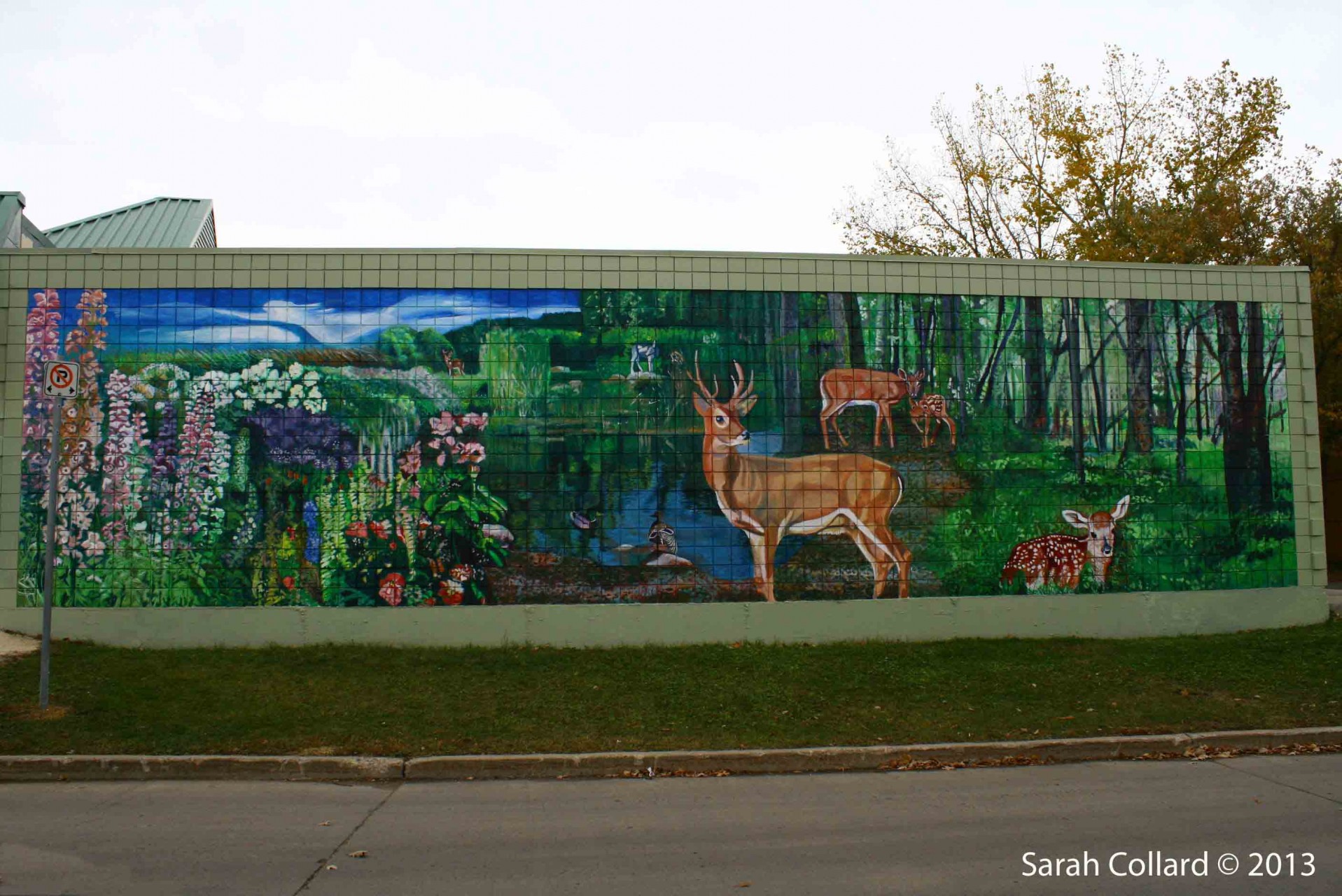Deer Environment, Moray Medical Clinic, 9.5’ x 47’, 3536 Roblin Boulevard, Winnipeg, MB, 2013, artist acrylic (Nova Colour) on cinder block
Sponsors: Councillor Havixbeck, Take Pride Winnipeg and Dr. Paul Walton.
One of the most remarkable topics for conversation about the Charleswood area in Winnipeg are the deer. Anybody who lives there comments on their prolific presence. Deer are everywhere. They very commonly feed from planters, grass, trees and just about any green leafy vegetation in the area. However, they do not understand property lines, so they roam freely from one house to the next, picking and choosing their meal. Recently I stayed with a nice lady, Anne Ruhr in the East St. Paul area and I noticed her evergreens were eaten bare 5 ft up the trunk. She said they were fearless and would come right up to the house, any time of year but were particularly more common now that new houses were built close by, clearing out the abundant bush leaving the deer with no food supply. Charleswood is a residential area in Winnipeg, west of Tuxedo and Assiniboine Park. The infamous park hosts the Assiniboine Park Zoo, The Pavilion holding the permanent collection of Ivan Eyre paintings, the English Gardens, the Leo Mol Sculpture Garden and it is set in a natural treed area with many paths for walking. Just south of the Zoo between Roblin Boulevard and Wilkes Avenue, there stands Assiniboine Forest, a 1,100 acre natural forest marking the beginning of Charleswood and home for numerous aspen-oak trees and white tail deer.
For this Mural, I wanted to depict the deer in their natural environment, remaining sensitive to the locale. That is why I placed the deer in the forest, close to a pathway and water. The body of water is actually the pond found in the Assiniboine Gardens, surrounded by bull rushes and an actual Leo Mol sculpture of a deer. A couple mallard ducks are found in the foreground with peonies, fox gloves, status, lupins and hollyhocks found to the left, suggesting the nearby English Gardens. The tall prairie grasses line the background sky. An angel appeared in the clouds when I was painting it, completely unconsciously. The white tail deer will often live in fields and meadows favouring broad-leaved trees and they will sleep in forests for shade. While mating, or in a rut, the bucks will fight over territory using their antlers in sparring matches. Killing deer during hunting season can be a favoured Manitoba sport. Men rally for the largest racks and mount them in their living rooms as pride trophies. During the creation of this Mural, a friend of mine from the city came by to check on me. After he had returned home and my day was almost up, I noticed a buck slowly peer its head around the corner. It caught me off guard. After an uproarious laugh, I realized it was my friend playing a joke on me. He had gone home, took the rack off his wall and propped it up to trick me. It worked. Recently CBC reported a decapitated deer found in the Charleswood area, one month after I painted this mural (November 25, 2013). They suspect someone wanted it as a trophy, but reminded the public of hefty fines for poaching. Deer are so prevalent in Manitoba that it is considered common place to see them at the edge of a highway, run across the road or unfortunately be found as road kill. Manitoba Public Insurance spends $31 million each year on wildlife collision claims. That is almost the same figure as their drunk driving claims. So if you are in the Charleswood area, be on the look out for deer, but be sure to go see my mural on the side of Moray Medical Clinic at 3536 Roblin Blvd, the corner of Princeton Blvd.
A baby deer or fawn is located in the grass to the right of the composition. They have a reddish-brown coat with white spots that helps them blend in with the forest. White-tailed deer are vegetarians (herbivores), leisurely grazing on most available plant foods such as leaves, twigs, fruits and nuts, grass, corn, alfalfa, and lichens and other fungi. Occasionally venturing out in the daylight hours, white-tailed deer are primarily nocturnal, browsing mainly at dawn and dusk. The other species I wanted to highlight was the mallard ducks, widely known in North America preferring the low lying areas that are calm, undisturbed. Mallards prefer shallow sanctuaries, but can be found in almost any body of freshwater and are commonly found in wetlands. The drake, or male, is the more colourful mate. Its green head sits on a white neckband that sets off a chestnut-coloured chest and grey body. Females are drab brown in colour, but sport iridescent purple- blue wing feathers that are visible as a patch on their sides. There is a buck in the foreground, a doe behind with two fawns. This family of deer are the feature presentation in this Mural and important to this area. They are joined by a buck far off in the distance, above the peonies.

